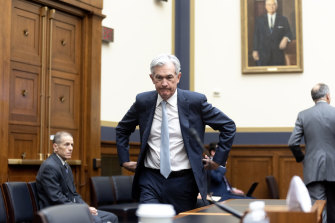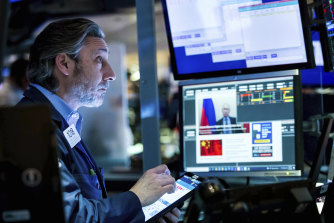Opinion
Shock US inflation a rude reality check for already shaken markets
Stephen Bartholomeusz
Senior business columnistAfter Friday’s shock inflation readings, the US Federal Reserve Board meeting that starts on Tuesday is predestined to produce an outcome that will further destabilise shaken markets and add more pessimism to an already-gloomy global economic outlook.
The 8.6 per cent headline US inflation rate for May – another 40-year record – dashed hopes that had been raised by an April reading of 8.3 per cent that seemed to suggest the rate had peaked.
Inflation in the US and elsewhere now appears entrenched and spreading beyond the impact of dysfunctional supply chains and soaring energy prices. The May increase is disconcerting, given that the US is cycling inflation numbers that were already surging at this time last year.

US Fed chairman Jerome Powell.Credit:Julia Nikhinson
The US data came a day after the European Central Bank foreshadowed its first rate rise in more than a decade at next month’s meeting and announced it would end its eight-year-old program of massive bond purchases on July 1.
That news drove European bond yields up – particularly those issued by southern European governments – again raising the spectre of divergence and fragmentation of the European Union that has periodically erupted in the post-200 financial crisis era.
ECB president Christine Lagarde foreshadowed a 25 basis point increase in the bank’s policy rate at next month’s meeting, followed by more rate rises later in the year, in response to a surge in inflation that the ECB estimates will hit 6.8 per cent this year. The ECB’s key rate is now minus 0.5 per cent.
The pressure on Europe’s unity – manifested in earlier crises like “Grexit” and “Italexit” –is mounting again, with the spreads between the rates on bonds issued by the stronger northern European economies like Germany and France and those in southern Europe blowing out.
Germany’s 10-year bonds are trading on yields of about 1.5 per cent. Italy’s are at 3.75 per cent and Greece’s at 4.36 per cent.
Given their debt levels – Italy’s debt-to-GDP is expected to go close to 150 per cent by the end of this year and Greece’s closer to 190 per cent – the prospect of rapidly rising European rates threatens more economic and political instability for already vulnerable economies.
What happens in America is, of course, of great significance to the Europeans and the rest of the world because a more aggressive approach from the Fed – and it is inevitable that the latest inflation data will force a more aggressive approach – will impact the rest of the world via capital flows, US dollar borrowing costs and exchange rates.
Across Asia and the rest of the heavily-indebted developing world, the combination of the strong dollar, rising interest rates, sky-high energy prices and the global economic slowdown is threatening.
Even Japan, which doesn’t yet have an inflation problem – its rate has been around 2.5 per cent – is being impacted via the exchange rate, with the yen depreciating about 15 per cent against the US dollar so far this year. While that traditionally aids Japan’s exports, it is starting to hurt because the cost of the raw materials and the energy Japan imports (and pays for in US dollars) is soaring.
Across Asia and the rest of the heavily-indebted developing world, the combination of the strong dollar, rising interest rates, sky-high energy prices and the global economic slowdown is threatening.
Rising rates in the US pose a dilemma for central banks, like our Reserve Bank, because of their effect on currency relativities and, should their currencies weaken significantly, the prospect of importing inflation via higher import prices. The Fed’s decisions heavily influence global monetary conditions and policies.

The tech-heavy Nasdaq is down 28.5 per cent since the start of the year.Credit:AP
When the Fed’s chairman, Jerome Powell, discloses the outcome of the meeting of its Open Market Committee meeting that ends on Wednesday it is probable that he will reveal the second 50 basis point rise in this cycle and the Fed’s third rate rise this year. He will almost certainly signal another 50 basis point rate rise at the next meeting late next month and more increases before year-end.
For markets that believed the worst might have been over when the April data appeared to show inflation had peaked – equity and bond markets responded positively to that data – the release of the May numbers was a rude reality check.
The US market slumped another 2.9 per cent on Friday, with the Nasdaq index down more than 3.5 per cent.
The overall sharemarket is now down about 18.7 per cent since the start of this year and the technology stock-heavy Nasdaq index 28.5 per cent as what had been – for nearly 14 years – the safety net provided by the Fed’s sensitivity to market volatility has been withdrawn.
Bond yields, which had fallen back after last month’s apparently encouraging signs that inflation was peaking, have jumped.
The yield on two-year US Treasury notes has risen about 21 basis points, to 3.06 per cent, this month and the 10-year bond rate more than 40 basis points to 3.16 per cent. The Australian 10-year bond rate is now 3.67 per cent. It started this year at 1.67 per cent.
The rebound in the US inflation rate came after what had appeared to be encouraging signs that the worst of the supply chain issues that helped ignite the outbreaks were easing, with semiconductor prices falling and the cost of shipping containers also declining sharply. The consumer binge that was a feature of the pandemic and post-pandemic environments also appeared to be losing momentum.
Russia’s invasion of Ukraine and its impact on energy and food prices and the continuing interruptions to global supply from China’s zero tolerance for COVID (just as it appeared Shanghai and Beijing were reopening after strict lockdowns, mass testing in those key economic centres resumed at the weekend) have created an elevated floor under global inflation levels.
The persistence of inflation rates at levels not seen since the dark days of the 1970s and early 1980s gives central banks few options but to go even harder with rate rises and the continued withdrawal of the vast injections of liquidity from the unconventional policies that had remained in place, until very recently, since the 2008 financial crisis.
The expansive policies central banks pursued in response to the financial crisis and, more recently, the pandemic produced a raft of unintended, or at least incidental, consequences, including bubbles in asset markets and negligible-to-negative interest rates.
The next episode of monetary policies from the key central banks will do something similarly transformational, albeit that the unintended consequences of the abrupt, inflation-driven U-turn in those policies are already, in their earliest phase, taking the world in a very different and even less palatable direction.
The Business Briefing newsletter delivers major stories, exclusive coverage and expert opinion. Sign up to get it every weekday morning.